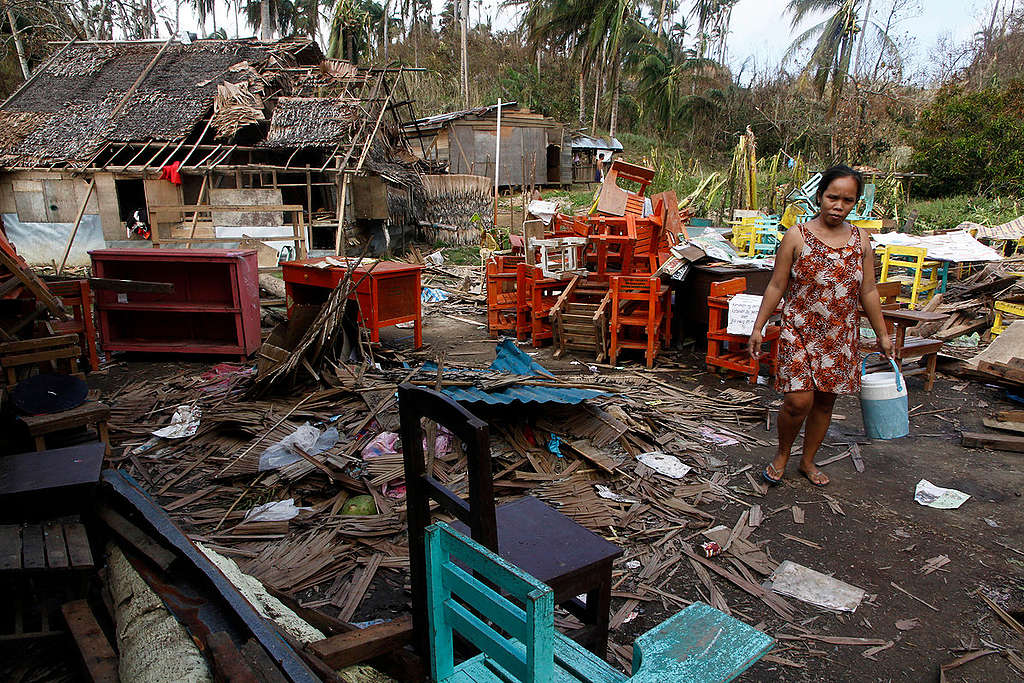Quezon City — Greenpeace today called on the Philippine government to put climate action and climate disaster risk reduction (DRR) at the heart of its COVID recovery strategy.

The group made the call on International DRR Day, following the release of a UN report [1] that shows a “staggering rise” in climate disasters in the past 20 years. The report named the Philippines as the 4th country hardest hit by natural disasters, mostly from climate-related events.
“Unless the worst impacts of the climate crisis are averted, the cost in human lives and economic losses will continue to rise to catastrophic proportions,” said Greenpeace Philippines Climate Justice Campaigner Virginia Benosa-Llorin. “The Duterte administration must use the opportunity of the COVID recovery to build in strong climate action into a response that will enable the country to weather other future crises that may happen alongside the climate emergency.”

The Global Climate Risk Index 2020 [2] published by the Germanwatch, ranked the Philippines as the 2nd country most affected by impacts of weather-related loss events in 2018. Meanwhile, the Philippines ranked 1st on the list of countries facing the highest risk of climate change hazards in a report by the Global Peace Index [3]. The impacts of climate change—including increases in ocean warming and other climate-related stressors—threaten coastal ecosystems and the services, goods and benefits that the majority of Filipinos depend on. Greenpeace research as early as 2007 [4] shows that only one of the 16 regions of the Philippines is not vulnerable to a one-meter rise in sea level, and the regions and provinces most susceptible to sea level rise, extreme weather events, and landslides are also among those with the highest poverty incidence.
Greenpeace believes that responding to COVID and other crises in a climate-changed world means putting the well-being of people and nature first. Concretely, this means directing finance to green, people-centred investments across a range of public sectors: health, energy, transport, water, food, waste, and education. This can be reflected in a national budget that invests in people’s health and wellbeing as a strategy for resilience and sustainability.
Last month, the environmental group renewed its calls for President Rodrigo Duterte to issue a Climate Emergency Declaration that will put climate action at the center of all policy decision-making from local to national level. Greenpeace, who is willing to help the government craft the document, says the declaration should ensure the Philippines’ rapid and just transition to a low-carbon pathway through the phaseout of coal and fossil fuel investments, as well as uphold climate justice for millions of Filipinos by holding fossil fuel companies accountable for the climate crisis.
“Greenpeace is renewing our call for the President to issue a Climate Emergency Declaration,” said Llorin. “With strong, coordinated climate action, we can make our cities and country safer and ready for any crisis, through policies that would enable a better normal to protect communities from the effects and impacts of climate change.”
Notes to editors:
[1] Human Cost of Disasters: An overview of the last 20 years 2000-2019. https://www.undrr.org/news/drrday-report-dramatic-rise-climate-disasters-over-last-20-years
[2] Germanwatch, “Global Climate Risk Index 2020,” available at https://germanwatch.org/sites/germanwatch.org/files/20-2-01e%20Global%20Climate%20Risk%20Index%202020_14.pdf , last accessed on 30 September 2020
[3] Institute for Economics and Peace, “Global Peace Index,” available at http://visionofhumanity.org/app/uploads/2019/06/GPI-2019-web003.pdf
[4] https://www.greenpeace.org/philippines/story/1327/maps-show-rp-on-road-to-climate-change-catastrophe/
Media contact:
Angeli Cantillana
Communications Campaigner, Greenpeace Southeast Asia – Philippines
[email protected] | +63 998 595 9733



